So when it comes to responsive PDFs and web publications, which is the better bet for your content?
The answer is web publications every time.
If you're happy to take our word for it—good for you; off you pop, get back to creating and hosting the most trackable, on-brand, and easy-to-create-and-deliver content FOR EVERY DEVICE EVER.
For those who need a little more information to prove the point, the following explores both presentation types, what they offer, their pitfalls, and their advantages.
Oh, and of course, the myriad reasons why web publications keep coming out on top as the most mobile friendly content format.
What are responsive PDFs?
In a word, clumsy.
In the good old days, when printing documents and posting them to leads was still all the rage, Adobe developed an amazing piece of kit that unified all the different publishing packages. It allowed each publisher to output their documents in a single, super-friendly format that the entire world could access and read for free.
That was a great play—actually groundbreaking. Well played, Adobe; we salute you for that.
But, as life progressed, the world moved forward, printing slowly started to lose flavor, and reading documents on desktop machines moved to mobiles and tablets—much smaller screens on all accounts! That meant—with so much information falling off the screen or at unreadable tiny font sizes—it requires a lot of pinching, zooming, and scrolling, all to try and read the information in those set-size and format PDF presentations.
See? Clumsy.
But wait! Introducing Adobe Reader Liquid View
Adobe is nobody's fool! They spotted the problem right away and developed a potential solution to bring peace to the PDF-producing masses.
Liquid View uses Adobe’s artificial intelligence tool, Sensei, to check all the text and image elements of a file, ordering them accordingly and displaying them in the ideal size for whichever mobile or tablet they appear on, on iOS or Android.
Brilliant.
Or is it?
What are the drawbacks of responsive PDFs?
Sadly, Liquid View is far from ideal.
For a start, as far as we know, at the time of press, Liquid View is only available in Acrobat, Adobe’s PDF viewer. That means in order to read the content, the reader will have to download and save each file to their Acrobat app. In turn, that means downloading yet another tool to your device (not a huge hassle, admittedly, you only have to do that once, after all, but it doesn't make the format universal).
Are they really going to be happy with those unnecessary extra steps? No, of course, they're not.
You want your files to open in-browser or within the social media app that you're scrolling—immediately. Good tech is designed to make light work of every task, so why would you choose to go some extra mile you shouldn't have to?
Second, the creator needs to tag each element to determine the order in which it's shown when resized. Even with Sensei doing its best, text blocks and images in files created without those tags can end up displayed in all kinds of funky orders.
Okay, you can recreate or tag your existing files, but most of them are already out there, safely stored on your customers' devices, with no way of you recalling and editing them.
That ship, we're afraid, has sailed.
The other massive gasp of despair made by marketers around PDF use is that the only trackable data you can measure is the number of downloads. In a world where data drives lead generation, sales, content refinement, SEO, and conversions, we have to admit PDFs are a nightmare when trying to track or improve any of those elements. In fact, it's impossible.
What are web publications?
In a word, the future.
Okay, technically, that's two words. How about awesome, then? Is that better?
A web publication is an interactive set of pages that provides the same type of content you'd typically save for PDFs. Consider them a kind of microsite that delivers a particular report, paper, case study, or whatever else you don't want to get lost in your blog or within the myriad pages of your website.
They have their own unique URL, with a carefully constructed page flow, ensuring your readers aren't overwhelmed with heavy, cramped pages of text but clear and steady sections in easy-to-consume chunks.
And guess what else? Because they're built on the same technologies as your website (HTML and CSS), you can pack them full of rich media and interactive elements; all the cool things that never worked in PDFs. So if you want to see just how much better our web publications perform compared to animated PDFs, why not read our blog about it?
Website technology without the heavy lifting
So, I hear you thinking, “Building a website takes time, skills, and a whole load of other resources; we haven’t got time for that for each document we need to send out —sorry, we’re out.”
Not so fast! Building web publications on a content creation platform like Foleon is quick and easy. It's exceptionally intuitive, and with your standard brand elements outlined in common styles, the design work takes care of itself.
And because it's a drag-and-drop system, you'll never have to write a single line of code.
We calculated that you could build 432 web publications in the same time it would take to deliver a new website.
Again, the facts about how different web publications work compared to a traditional website are in another of our blogs (along with how we made that calculation). See for yourself; you'll learn more about how much they offer.
Responsive, like no other report, magazine, or user manual
Getting back to our initial argument, as you can imagine, with such a progressive tool at your fingertips, it would be crazy if it wasn't responsive. Resizing for different devices is automatic, with templates and views that show you how every step and stage will appear, so everything looks just how it should on every screen.
Better still, you can tweak your pages to ensure that each element is the ideal size and placement for the screen size. And finally, it offers ultimate control in delivering your images, videos, quizzes, tools, maps, or contact forms. Cool, huh?
Want to know more about how you do that? We'd love to show you; we're so proud of its editor that we've shared precisely how its responsive feature works.
What are the advantages of using web publications?
We’ve touched on a few advantages when using web publications, but if you want some kind of inclusive list, how about this to get things going?
- Interactive content with all the video, audio, and rich media you can imagine
- Quick to create, on brand, and with an easy, intuitive drag-and-drop system
- Aesthetically designed, professional templates
- Simple, easy-to-follow, and navigate content
- Completely compatible with SEO, like PDFs never could
- Scalable and editable content – banishing out-of-date information forever
- Collaboration on topics between all of your teams
- Centrally managed media and resources
- Content gating at any point on your pages
- Shared templates, ensuring all teams' output remains uniform
- Packed with insight opportunities and actionable data
- Fits perfectly with your existing marketing and production tech stack
- Oh, and everything is completely trackable—your marketing team is going to LOVE them
We could go on, but you get the idea. If you're still not convinced, why not take our tour? Seeing is believing, as they say.
Data converts — why wouldn't you want a piece of that action?
The last bullet point on the list above is the part of web publications that your marketing teams are going to go nuts about.
Let’s consider the data you get from hosting your PDF papers, reports, and magazines. What can you measure? Well, you can monitor how many times they're downloaded, and that’s it.
What can you monitor and measure with web publications? ONLY EVERYTHING! Because your pages are hosted online using the typical tools of traditional web pages, you can track EVERYTHING, including your ROI.
You can track:
- How many pages are read
- How long readers spend on each page
- Which pages they share
- Which page they exit the document
- The most popular content, chapters, and sections
- How many times they watch your videos
- Which links they click
- Which pages drive traffic to communication, sales, and conversions
- How many times they complete your quizzes, use your tools, explore your maps and memes, or play your games (Games? You never found those in a PDF!)
- Monitor where readers enter your content marketing funnels
- Monitor the points users share their contact info
It's an incredible tool for monitoring and qualifying leads and fine-tuning your content to bolster results.
Come on, what more do you want? Free ice cream? Well, of course, you do…
Final thoughts
With so many advantages of such an engaging system, it's hard to imagine why every business isn't choosing responsive, interactive web publications over their old-fashioned static, struggling, downloadable PDFs.
There are two types of people in this world, those who embrace the future and take full advantage of what it offers, and those who are afraid of change and fail to take their next best step.
Which one will you be?
Don't let all that valuable data go to waste. Your marketing team will never forgive you.
.png?width=1600&name=Frame%2029%20(2).png)


